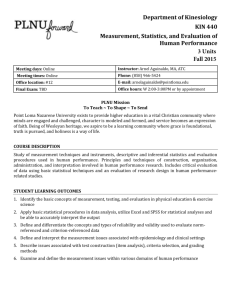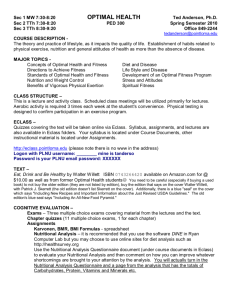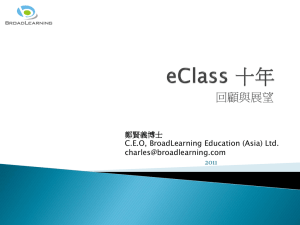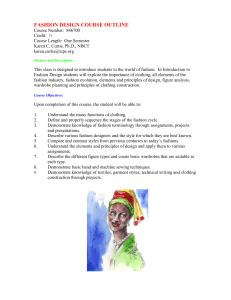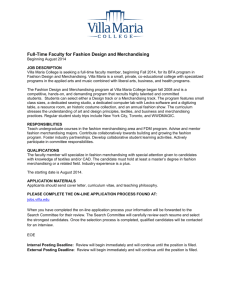FCS 375 (2) Visual Presentation and Display Fall 2012
advertisement
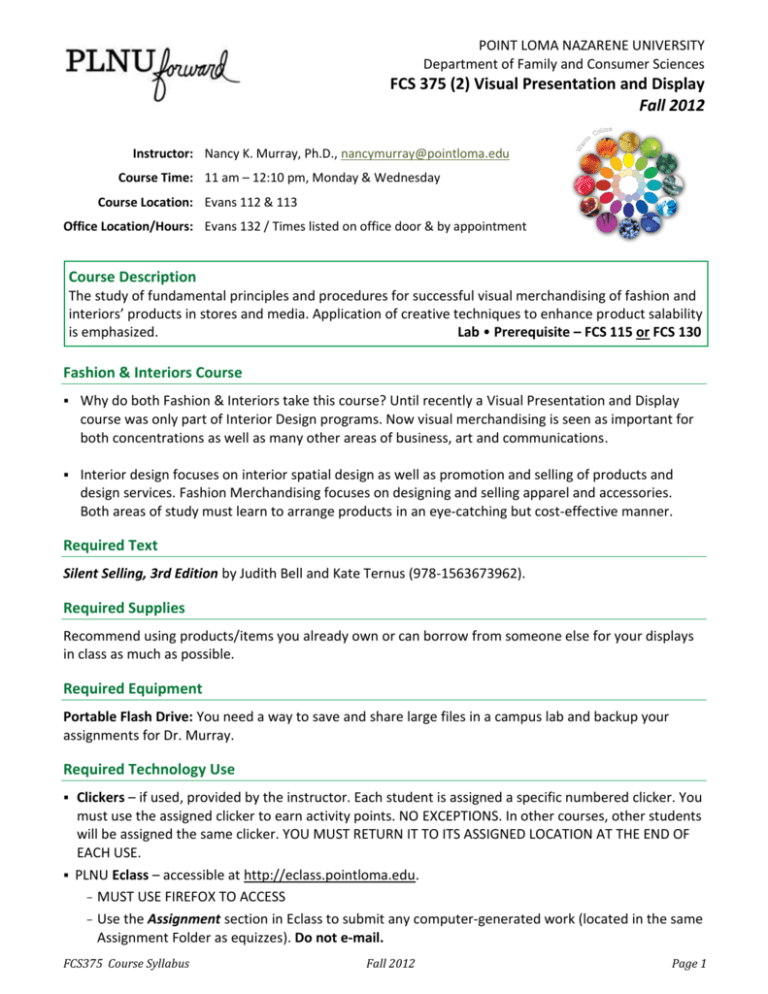
POINT LOMA NAZARENE UNIVERSITY Department of Family and Consumer Sciences FCS 375 (2) Visual Presentation and Display Fall 2012 Instructor: Nancy K. Murray, Ph.D., nancymurray@pointloma.edu Course Time: 11 am – 12:10 pm, Monday & Wednesday Course Location: Evans 112 & 113 Office Location/Hours: Evans 132 / Times listed on office door & by appointment Course Description The study of fundamental principles and procedures for successful visual merchandising of fashion and interiors’ products in stores and media. Application of creative techniques to enhance product salability is emphasized. Lab • Prerequisite – FCS 115 or FCS 130 Fashion & Interiors Course Why do both Fashion & Interiors take this course? Until recently a Visual Presentation and Display course was only part of Interior Design programs. Now visual merchandising is seen as important for both concentrations as well as many other areas of business, art and communications. Interior design focuses on interior spatial design as well as promotion and selling of products and design services. Fashion Merchandising focuses on designing and selling apparel and accessories. Both areas of study must learn to arrange products in an eye-catching but cost-effective manner. Required Text Silent Selling, 3rd Edition by Judith Bell and Kate Ternus (978-1563673962). Required Supplies Recommend using products/items you already own or can borrow from someone else for your displays in class as much as possible. Required Equipment Portable Flash Drive: You need a way to save and share large files in a campus lab and backup your assignments for Dr. Murray. Required Technology Use Clickers – if used, provided by the instructor. Each student is assigned a specific numbered clicker. You must use the assigned clicker to earn activity points. NO EXCEPTIONS. In other courses, other students will be assigned the same clicker. YOU MUST RETURN IT TO ITS ASSIGNED LOCATION AT THE END OF EACH USE. PLNU Eclass – accessible at http://eclass.pointloma.edu. - MUST USE FIREFOX TO ACCESS - Use the Assignment section in Eclass to submit any computer-generated work (located in the same Assignment Folder as equizzes). Do not e-mail. FCS375 Course Syllabus Fall 2012 Page 1 The Announcements section of Eclass will provide information about class assignments and course changes; each time you log into Eclass, check Announcements for new messages. Facebook used for easy photo access. Request to be Dr. Murray’s friend at www.facebook.com/DrNancyKMurray. - Student Learning Outcomes FCS Department > FCS Fashion & Interiors Program > FCS 375 Visual Presentation and Display DEPARTMENT PROGRAM COURSE 1. Students will demonstrate an 1.1 Identify how fashion or 1.1.1 Use visual presentation understanding of the multiple interior design products and methods to merchandise factors that influence the services are influenced by products. development and quality of physical and social life of individuals, families, environments as well as and communities throughout technological the lifespan. advancements. ASSESSMENT Assignment Presentations In-class displays Equizzes Final Exam 1.2 Apply knowledge of human development throughout the life cycle to meet specific design needs in the design and marketing of fashion or interior design products and services. 2. Students will identify appropriate resources to use in application for problem solving. 1.3.1 Recognize 1.3 Evaluate the effects of appropriateness of visual society and culture upon merchandising in society fashion or interior design and culture. trend development and the merchandising of fashion or interior design products and services. Assignment Presentations In-class displays Equizzes Final Exam 2.1 Apply design concepts and available materials and resources for appropriate end use. 2.1.1 Apply design principles to plan visual presentations and merchandise products. Assignment Presentations In-class displays Equizzes Final Exam 2.2 Collaborate with other preprofessionals to formulate design and merchandising solutions that apply and evaluate knowledge of the fashion or interior design industries. 2.2.1 Assess visual merchandising designs. Self and Peer Evaluation of inclass displays 3. Students will analyze research 3.1 Apply research methods, data or original published including forecasting works, and use critical techniques, for marketing thinking skills for evaluating fashion or interior design products, research, or products and services. theories. 3.2.1 Examine the methods and 3.2 Analyze theoretical and In-class displays processes used in visual appropriate practical Equizzes merchandising fashion elements of fashion or Final Exam and interiors products. interior design products and services in meeting specific 3.2.2 Identify common visual design or business needs. merchandising fixtures and their application to marketing fashion and interiors products. FCS375 Course Syllabus Fall 2012 Page 2 DEPARTMENT PROGRAM COURSE ASSESSMENT 4. Students will examine the 4.1 Apply professional practices, 4.1.1 Display professional value of societal diversity and procedures for business behavior. ethical treatment of others as profitability and career 4.1.2 Learn and use visual a result of their Christian success, and the role of merchandising faith. ethics in the fashion or terminology correctly. interior design industries. 4.1.3 Respect ownership of work product. 4.2 Analyze societal diversity considerations for merchandising fashion or interior design products and services. Punctual attendance and adherence to classroom policies recorded each class meeting Assignment Presentations In-class displays Weekly Equizzes Final Exam 5. Students will identify specialization career paths, and develop an appropriate career plan within a profession of Family and Consumer Sciences. Brand Project 5.1 Analyze career paths and appropriate career plan within the fashion or interior design industries. 5.1.1 Create a branding project to differentiate student from other preprofessionals. Policies and Procedures 1. Respect for Others and Classroom Atmosphere 1.1. ATTENDANCE and CLASS ACTIVITIES: Out of respect for everyone attending, class will begin promptly. Class attendance is essential for success in this course because it is the only opportunity to participate in class activities. Attending class is your current job. Show that you are responsible, and take this opportunity to invest in your future career. 1.2. ELECTRONICS: During class, electronics need to be used for course-related topics and participation. Taking notes and searching the Internet to contribute to discussions are valuable, but texting friends, answering e-mails, or listening to music distracts you and others from the focus of the class. 1.3. CLICKERS: Dr. Murray will provide any clickers used. You must use the one assigned to you or you will receive no points. 1.4. PUBLIC FEEDBACK BY INSTRUCTOR: Constructive public feedback will frequently be offered and solicited about the activities and assignments in this course. It is important for all to realize that this public sharing of what works and what doesn’t is an important part of growing as a knowledgeable professional. You will listen and understand what is being offered to you and learn to evaluate and express constructive feedback about the work done by your peers. This may be difficult to hear, but it is essential to learning in this field. 1.5. CLASSROOM/LAB USE: We all recognize that it is nicer to come into the room and find it clean and tidy. We all will take responsibility for using the room with respect and leaving it tidy regardless of the ease, convenience, or how we found the room. 2. Course Assignments 2.1. LATE POLICY: Due dates are enforced rigorously. It is only fair to reward those who keep to the schedule as this is an important value of the work world. 2.2. RUBRICS: Rubrics are used by the instructor to assess student performance. The purpose of a rubric is to ensure objective evaluation of assignments. Rubrics are shared before assignments are completed to provide details that should be used to guide creation of the assignments. It is important to your grade to include all the items that the rubric outlines. If digital, the required file name is included in the rubric. 2.3. REQUIRED FILE NAMES FOR DIGITAL ASSIGNMENTS: All computer-generated items that are electronically submitted for grading need to be saved with the file names assigned to them. This will ensure that your work is credited to you and easy for the instructor to find when it is saved to her computer. File names FCS375 Course Syllabus Fall 2012 Page 3 always start with your last name followed by the course number and assignment name. Example: Doe499-ProductAnalysis. 2.4. PDF FORMAT REQUIRED: Assignments created on one computer and opened on another computer frequently do not retain all formatting. You can protect your work from being corrupted by saving in a PDF format before submitting for assessment. How to create a PDF document will be demonstrated in class. 2.5. NONDIGITAL ASSIGNMENTS: Items that are not in a digital format are due at the beginning of class on the date specified in the schedule. 2.6. IN-CLASS PRESENTATIONS: In-class presentations are required for this course. Talking to fashion & interiors clients, workers, and vendors is a large part of what fashion & interiors’ professionals do at work. Displaying visual work product, describing the process, communicating the effectiveness of a solution, researching the market, selecting and negotiating with vendors, sourcing products, and working within a budget are all integral elements in the fashion & interiors’ professionals work product. There is much more to producing work product than just selecting products. 2.7. OWNERSHIP OF WORK PRODUCT: We like to show off our students’ work so the assignments completed in this course may be used in course materials, on the department website, posted on the instructor’s Facebook page, in grant applications, in scholarly publications, or in other materials. The instructor will never claim your work as her own, but it may be displayed without your name attached. 3. Eclass 3.1. NAVIGATING TO ECLASS: Equip your computer with Mozilla Foxfire version that ITS at PLNU supports for the use of Eclass. If you use a newer or older version of Mozilla Foxfire, or another browser such as Safari or Internet Explorer, any work you submit or access may not register with Eclass and you may miss deadlines, miss points or be unable to access information. 3.2. REGISTERING FOR ECLASS: This course has its website on what PLNU calls Eclass. You need to establish a password to sign in and access the online course for FCS 375. Use the same password as the one you use to access your PLNU portal. This will be demonstrated in class if requested. 3.3. USING ECLASS: Eclass provides access to course announcements, handouts, the PowerPoint presentations used in class, weekly quizzes, and for submitting all digital assignments for assessment. It is important to your success in the course that you regularly check Eclass and benefit from the information and announcements posted. Regularly is defined as at least three times a week and to include the day before each class meeting. 3.4. EQUIZZES: There is a quiz over the textbook reading each week. In order to receive any points for the weekly quiz, you must complete and successfully submit your answers before class begins on Thursday. Be sure to use the Mozilla Foxfire browser specified on eclass for all quizzes as other browsers may not work properly. The quiz for the next week appears after class on Wednesday or Thursday (whichever your course meets on), one week before it is due. 3.5. SUBMITTING DIGITAL ASSIGNMENTS: All assignments that are computer-generated are submitted via Eclass in the Assignment folder. Eclass stamps the time on your submission. Consider this due date and time as the deadline you must meet as you would with a client. Do not e-mail assignments. 3.6. DISCUSSION BOARDS: These are just like interacting in class—use appropriate language. 3.7. MY GRADES: You may access your grades on Eclass by visiting the Eclass website and selecting the My Grades option. By clicking the score you receive on a quiz, you can access the quiz questions and answers for future exams. Also, clicking the score for an assignment will give you access to grading comments from the instructor. Adding all your points earned together, and dividing by the possible points, will yield a percentage grade that can be compared to the grading scale. 4. E-mail 4.1. COMMUNICATION: A wonderful invention and the best way to contact Dr. Murray outside of class. 4.2. USE THESE GUIDELINES: 4.2.1. Use your pointloma.edu Gmail address. 4.2.2. Use the subject line effectively and include the course number. FCS375 Course Syllabus Fall 2012 Page 4 4.2.3. Allow 24 – 48 hours for a reply. 4.2.4. NO ALL CAPS. 4.2.5. E-mail is not for submitting assignments. 5. Emergencies EVERYONE HAS THEM: Be responsible, communicate promptly and privately, tell the truth, and don’t take advantage of the instructor’s goodwill. Each incident will be evaluated on its merits. Documentation may be requested. Academic Accommodations While all students are expected to meet the minimum academic standards for completion of this course as established by the instructor, students with disabilities may require academic accommodations. At Point Loma Nazarene University, students requesting academic accommodations must file documentation with the Disability Resource Center (DRC), located in the Bond Academic Center. Once the student files documentation, the Disability Resource Center will contact the student’s instructors and provide written recommendations for reasonable and appropriate accommodations to meet the individual needs of the student. See Academic Policies in the undergrad student catalog. Academic Honesty Policy PLNU Students should demonstrate academic honesty by doing original work and by giving appropriate credit to the ideas of others. As stated in the university catalog, “Academic dishonesty is the act of presenting information, ideas, and/or concepts as one’s own when in reality they are the results of another person’s creativity and effort. Such acts include plagiarism, copying of class assignments, and copying or other fraudulent behavior on examinations. A faculty member who believes a situation involving academic dishonesty has been detected may assign a failing grade for a) that particular assignment or examination, and/or b) the course.” See Academic Policies in the undergrad student catalog. The Department of Family and Consumer Sciences deems intellectual and academic integrity to be critical to academic success and personal development; therefore, any unethical practice will be detrimental to the student’s academic record and moral character. Students who present the work of others, which includes but is not limited to borrowing another student’s work, buying a paper, or using the thoughts or ideas of others as if their own (using information in a paper without citation), commit plagiarism. Students will be held accountable for plagiarized material. Plagiarized work will result in a failing grade for the assignment and possibly for the course. In either event, a written report will be filed with the department chair and be placed in the student’s academic file in the department office. FERPA Policy In compliance with federal law, neither PLNU student ID nor social security number should be used in publicly posted grades or returned sets of assignments without student written permission. This class will meet the federal requirements by (each faculty member choose one strategy to use: distributing all grades and papers individually; requesting and filing written student permission; or assigning each student a unique class ID number not identifiable on the alphabetic roster.). Also in compliance with FERPA, you will be the only person given information about your progress in this class unless you have designated others to receive it in the “Information Release” section of the student portal. See Policy Statements in the undergrad student catalog. Attendance and Participation Regular and punctual attendance at all classes is considered essential to optimum academic achievement. If the student is absent from more than 10 percent of class meetings, the faculty member has the option of filing a written report which may result in de-enrollment. If the absences exceed 20 percent, the student may be deenrolled without notice. If the date of de-enrollment is past the last date to withdraw from a class, the student will be assigned a grade of W or WF consistent with university policy in the grading section of the catalog. See Academic Policies in the undergrad student catalog. FCS375 Course Syllabus Fall 2012 Page 5 Incompletes and Late Assignments All assignments are to be submitted/turned in by the beginning of the class session when they are due—including assignments posted in Eclass. Course Grading Criteria APPROPRIATE BEHAVIORS HAVE BENEFITS Earn Points: Eclass Quizzes (15 x 10 pts) POINTS Final Exam In-Class Displays/Presentations (8x30) 150 100 240 rd 3 Party Planogram & Display Branding Project & Video 50 75 CD Portfolio 25 100 Community Building Total Points 730 INAPPROPRIATE BEHAVIORS HAVE CONSEQUENCES Lose Points: Using cell phones—texting, e-mail, etc. (each incident) Every 10 minutes of class missed Leaving early from class (in addition to above) varies: 1 to -10 -1 -10 Failure to clean up after yourself Failure to follow the policies and procedures (each time) -1 varies: 1 to -10 Failure to complete items by date due Failure to put your name on display rubrics -20% of item due -2 GRADE DISTRIBUTION A PERCENTAGE RANGE > 93% C PERCENTAGE RANGE 73-76% AB+ 90-92% 87-89% CD+ 70-72% 67-69% B B- 83-86% 80-82% D D- 63-66% 60-62% C+ 77-79% F < 59% GRADE GRADE Student Work Product Community Building – You are expected to know every class member’s name by the end of 2nd week Design 5 (10 points) – create a 5 minute (NO MORE) devotional or sharing to start the class. You can make us laugh or cry. Share your favorite scripture, your dream for the future, a story from your past, your bucket list etc. Help us start the class and get to know each other better. EVERYONE NEEDS TO LEARN TO BE ON TIME! Class Activities (5 points @) – based on the reading assignment and subjects already covered by that point in the course, contribute to discussion and problem solving. Create plans for displays and presentations in class. FCS375 Course Syllabus Fall 2012 Page 6 In-Class Displays and Presentations The 30 points for an in-class display or presentation are earned by completing all of the following: - Design a plan or planogram and submit to Dr. Murray for approval in the class before the display or presentation is due. - DISPLAYS o Follow your planogram to create a display by 11:30 a.m. in class on the due date. o Mount and display your planogram with your display for all to compare! o Evaluate your own display on the rubric provided (including comments). o Evaluate a peer’s display assigned to you by Dr. Murray (including comments). - PRESENTATIONS o o o Follow the plan discussed with Dr. Murray Create and present to class your presentation on video or PowerPoint/Keynote. Make comments on the audience feedback sheets for your own presentation and all of the one presented by your classmates. CLICKERS or paper ballots will be used for display evaluations: the displays will be assigned numbers and, via the clickers or ballots, we will poll the class to see which displays were evaluated on the rubric as most successful. 1. Prop Display Create a display using a prop as an essential element of the design. The prop is not a product you are selling nor is it a traditional display fixture; it is a support element. The prop may suggest the product to the viewer or just be the right size or color to fit into the desired look. Again, the prop is not the item being promoted so it should not overpower the product. It needs to be obvious what is for sale. 2. Home Fashion Seasonal Display Create a display using home fashion items that get the viewer into the mood for a season. This should be designed for a mantel, buffet or dining table. If for a dining table it must be a centerpiece viewable from 360 degrees. 3. Signage Display Video or PowerPoint Presentation Find a minimum of two examples of excellent signage for the same product or business in a visual presentation in an advertisement, magazine, website or store. Excellence may be achieved via the font, unusualness, creativity, etc. Often the best signage creates a theme via its look and consistency. Use your examples to show us more than a business sign on the door. Using video or still photos in a PowerPoint presentation share your research with the class. Clearly explain why you feel signage is an essential element in the visual presentation. 4. Lighting Display Video or PowerPoint Presentation Find a display at a store or design showroom that uses lighting as an essential element of the design. Look for something that if the lighting was missing, the impact of the display would be greatly diminished. Look for more than a few spotlights. Using video or still photos in a PowerPoint presentation share your discovery with the class. Clearly explain why you feel that light is an essential element in the display. 5. Décor Item (Partner Optional) Create a décor item for display in a store out of plastic bottles, paper or recycled items. Furniture and Designer Showrooms and stores like Anthropologie have made this kind of merchandising item very popular. The final result should be a finished piece with a clear purpose and description of store or showroom where it is designed to be used. No assembly needed when brought to class. A wall item should be mounted on a backing or framed. A tabletop or ledge item should be in a container or on a platform. There is no need to sell a product (although that would be great!), this is for general store or showroom ambience. It must “fit” the location. 6. Plastic Body Form Creation Create a work of art with the plastic body form you are provided. The idea is to make the plastic shape your own. Paint it, decoupage it, wrap it in duct tape, etc. Be creative! Whatever you do with the plastic, you still FCS375 Course Syllabus Fall 2012 Page 7 have to display a product on it or with it! PLAN AHEAD! Women’s and children’s sizes are available. Can use them as a décor item like artwork. 7. Plastic Body Form Display Create a display using your work-of-art body form. Your form must be an essential element of the display— do NOT cover it all up! No need to display it with clothing. Be creative! 8. Wild Card Displays Within a 15 minute time period, each member of the class is asked to bring 10 – 15 items that could be used in displays. The items can be products or props such as table settings, placemats, home accessories, art work, clothing, makeup, shoes, sporting equipment, jewelry, fancy boxes, frames, fabric for draping, lamp, furniture, seasonal decorations, etc.—whatever you can find. A multiple of similar items, or the same item in several colors, is useful. All items will be returned to the student who brought them at the end of the class period. - By random draw, each student will select five items and may repeat the selection process in the same draw order as many times as desired. - All students may make a simple sign by hand or on the computer to add to the items selected. - Each student will then be given two opportunities to make a display from these items. In-Class 3rd Party Display PLANOGRAM & ALL MATERIALS FOR DISPLAY Learn to give directions to subordinates at work. Create a detailed planogram for a display. Collect and bring to class on assigned day all the materials needed to complete the planogram display. Don’t share this with your friends! Each student will create a display using another student’s planogram and materials. No collaboration will be allowed! You will be in a different room than the creator of your assigned display and vice versa. CD Portfolio FCS 375’s portfolio includes the following: rd pictures of each display (EXCEPT 3 PARTY and WILD CARD) and a scan or picture of planograms for each rd display (EXCEPT 3 PARTY and WILD CARD) PDF copies of each presentation What is your brand? storyboards and video Summary write-up of FCS 375 – lastname-375-coursesummary Summary write-up should be a minimum of one page MS Word Document identifying what the course was about and what you learned. Place all items on a CD in a case to turn in on due date in schedule. The actual CD must have your complete name written on it along with the course number and name. Course Outline 1. PREPARATION FOR VISUAL CREATIVITY a. Creative Thinking: Getting “Out of the Box” b. Lighting 4. VISUAL PRACTICES FOR NONTRADITIONAL VENUES b. What is Visual Merchandising? a. Grocery and Food Service Stores c. Core Design Strategies b. Nontraditional Retailing 2. PRACTICES & STRATEGIES FOR THE SELLING FLOOR 5. TOOLS AND TECHNIQUES FOR MERCHANDISE DISPLAY a. Layout and Fixtures for Fashion Apparel a. The Magic of the Display Window b. Fashion Apparel Wall Setups b. Mannequins and Mannequin Alternatives c. Fashion Apparel and Accessory Coordination c. Building a Visual Merchandising Department d. Home Fashion Presentation 3. COMMUNICATING RETAIL ATMOSPHERICS 6. CAREER STRATEGIES a. Visual Merchandising Careers a. Signing FCS375 Course Syllabus Fall 2012 Page 8 Course Schedule – Mondays & Wednesdays Schedule subject to change if circumstances require. Activity Points are awarded only for work completed in class! Miss class, NO points. DATE Aug 28 Aug 29 Sep 3 Sep 5 LECTURE TOPIC ASSIGNMENT Introduction and Requirements for Class Creative Thinking What is Visual Merchandising? Eclass Quiz due before class begins Create a Color Wheel, Translate to Grayscale Scans DUE to Eclass by NOON Tuesday, Sep 6 Labor Day—No Class Eclass Quiz due before class begins Applying Core Design Strategies Discuss and Evaluate Color Wheels Chapter 1-2 5 Activity Points Chapter 1 -3 10 Equiz Points 5 Activity Points Chapter 3 10 Equiz Points 5 Activity Points Sep 10 Selling Yourself Activity: “What is Your Brand?” 5 Brand Points Sep 12 Eclass Quiz due before class begins Layout and Fixtures for Fashion & Interiors Products Wall Setups for Fashion & Interiors Products Chapter 4- 5 10 Equiz Points 5 Activity Points Sep 17 Planogram and Story Boards Creation Chapter 15 5 Activity Points Sep 19 Eclass Quiz due before class begins Fashion & Interiors Products Coordination including Props Prop Display Planogram Due Chapter 6 10 Equiz Points 5 Activity Points Sep 24 Prop Display Due 30 Display Points Sep 26 Eclass Quiz due before class begins Home Fashion Seasonal Tabletop Planogram Due Chapter 7 10 Equiz Points 5 Activity Points Oct 1 Home Fashion Seasonal Tabletop Display Due 30 Display Points Oct 3 Eclass Quiz due before class begins Signs—Do you need them? Signage Comparison Presentation Plan Due Chapter 8 10 Equiz Points 5 Activity Points Oct 8 Signage Comparison Presentation Due 30 Display Points Oct 10 Eclass Quiz due before class begins Lighting Lighting Presentation Plan Due Chapter 9 10 Equiz Points 5 Activity Points Oct 15 Lighting Display Presentation Due 30 Display Points Oct 17 Eclass Quiz due before class begins Food Retailing: How does it vary from fashion & interiors products? Oct 22 What is Your Brand? Video Storyboards Due Oct 24 Eclass Quiz due before class begins Nontraditional Retailing Décor Item Planogram Due Chapter 10 10 Equiz Points 5 Activity Points Chapter 15 10 Brand Points Chapter 11 10 Equiz Points 5 Activity Points FCS375 Course Syllabus Fall 2012 Page 9 DATE LECTURE TOPIC ASSIGNMENT Oct 29 Décor Item Due 30 Display Points Oct 31 HALLOWEEN – Want to dress up? Eclass Quiz due before class begins The Magic of the Display Window Chapter 12 10 Equiz Points 5 Activity Points Nov 5 What is Your Brand? Video Footage Recording/Editing 10 Brand Points Nov 7 Eclass Quiz due before class begins Mannequins and Mannequin Alternatives Plastic Body Form Planning and Creation Plastic Body Form Planogram Due Chapter 13 10 Equiz Points 5 Activity Points Nov 12 Plastic Mannequin Creation Due 30 Display Points Nov 14 Eclass Quiz due before class begins Brand Video DUE Visual Merchandising Careers Chapter 15 10 Equiz Points 50 Brand Points Nov 19 Display Mannequin or Mannequin-like Activities Plastic Body Form Display Planogram Due PLNU POLICY—MONDAY BEFORE THANKSGIVING ATTENDANCE MANDATORY—NO MAKEUPS ALLOWED 5 Activity Points Nov 21 Thanksgiving Break—No Class Nov 26 Plastic Body Form Display Due 30 Display Points Nov 28 Portfolio on CD in case Due Design 3rd Party Display Planogram 25 Portfolio Points 5 Activity Points You MUST be on time or NO POINTS EARNED 3rd Party Planograms, Materials, and Display Due 50 Display Points Dec 3 Dec 5 Eclass Quiz due before class begins Building a Visual Merchandising Department Wild Card Displays (no planograms required) Bring 10-15 items for in class displays on the fly COMPREHENSIVE FINAL EXAMINATION Dec 10 WEDNESDAY, 10:30 am – 12:30 pm Chapter 14 10 Equiz Points 30 Display Points 100 Exam Points Successful completion of this class requires taking the final examination on its scheduled day. The final examination schedule is posted on the Class Schedules site. No requests for early examinations or alternative days will be approved. FCS375 Course Syllabus Fall 2012 Page 10
